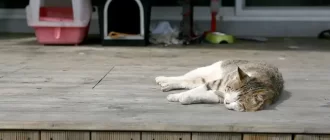Hind leg paralysis in cats is typically characterized by a sudden inability to move or utilize their hind legs. The cat may drag the rear legs while attempting to move, showing no control on the affected limbs. In some cases, the cat may express symptoms of distress or pain, along with a loss of bowel and bladder control. It becomes impossible for them to manage stairs, jump up or land from a height.
Causes of this Paralysis
There are several causes of sudden paralysis of the hind legs. Some of the primary ones include:
- Trauma: This could be from a fall, accident, or attack by another animal leading to spinal injuries.
- Thromboembolism: This condition obstructs the blood flow in a major artery, thereby causing paralysis.
- Infectious diseases: Some infections like Feline Infectious Peritonitis can result in nervous disorders, leading to paralysis.
- Neurological disorders: Diseases such as tumors or degenerative myelopathy can result in hind leg paralysis.
- Toxicity: Certain toxins, like those ingested through poisonous plants, can damage the nervous system severely enough to cause paralysis.

What Veterinarians Advise
Medical experts recommend immediate action if hind leg paralysis symptoms are noticed in your cat. Delaying could lead to permanent disability and even life-threatening situations. A proper diagnosis involves a comprehensive physical examination, blood tests, X-rays or MRI scans, and other tests as needed.
Treatment for Sudden Paralysis
Treatment varies widely depending on the root cause of the paralysis. Some of the potential treatments might include:
- Surgery: In cases of trauma or conditions like spinal cord herniation or tumor, surgical intervention can be a treatment option.
- Medication: For thromboembolisms, anticoagulants can be prescribed to restore blood flow. Antibiotics or antiviral drugs can be used when infections lead to paralysis.
- Physical therapy: Along with other treatments, physical therapy can help to regain strength and motor function.
Preventing Hind Leg Paralysis In Cats
Prevention strategies largely rely on mitigating the risk factors:
- Regular check-ups to detect and treat diseases early.
- Keeping cats indoors to protect them from accidents, attacks, toxic substances, and potential infectious agents.
- Providing a balanced and healthy diet to avoid heart-related diseases that could lead to paralysis.
- Regular exercise and play to keep their body and muscles strong.
In conclusion, sudden hind leg paralysis might be distressing and scary both for the pet and its owner, but understanding the potential causes, symptoms, and treatments can lead to a quicker recovery. The key is to be quick in noticing symptoms and seeking veterinary help.






